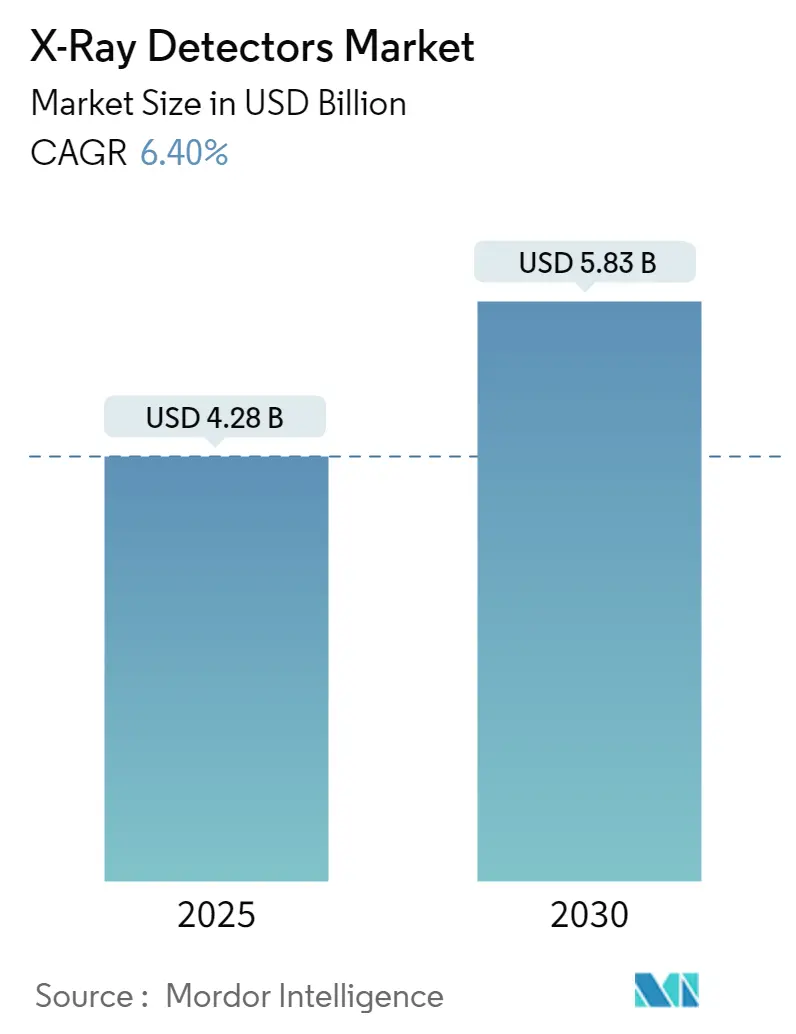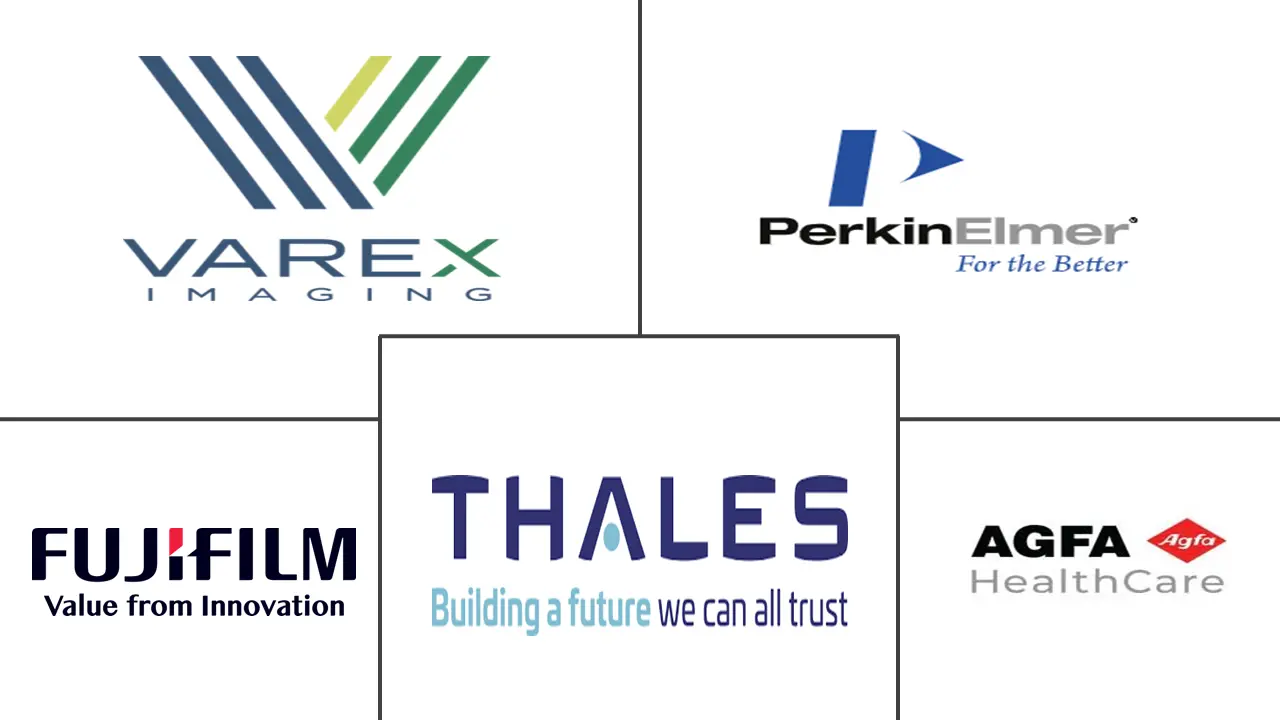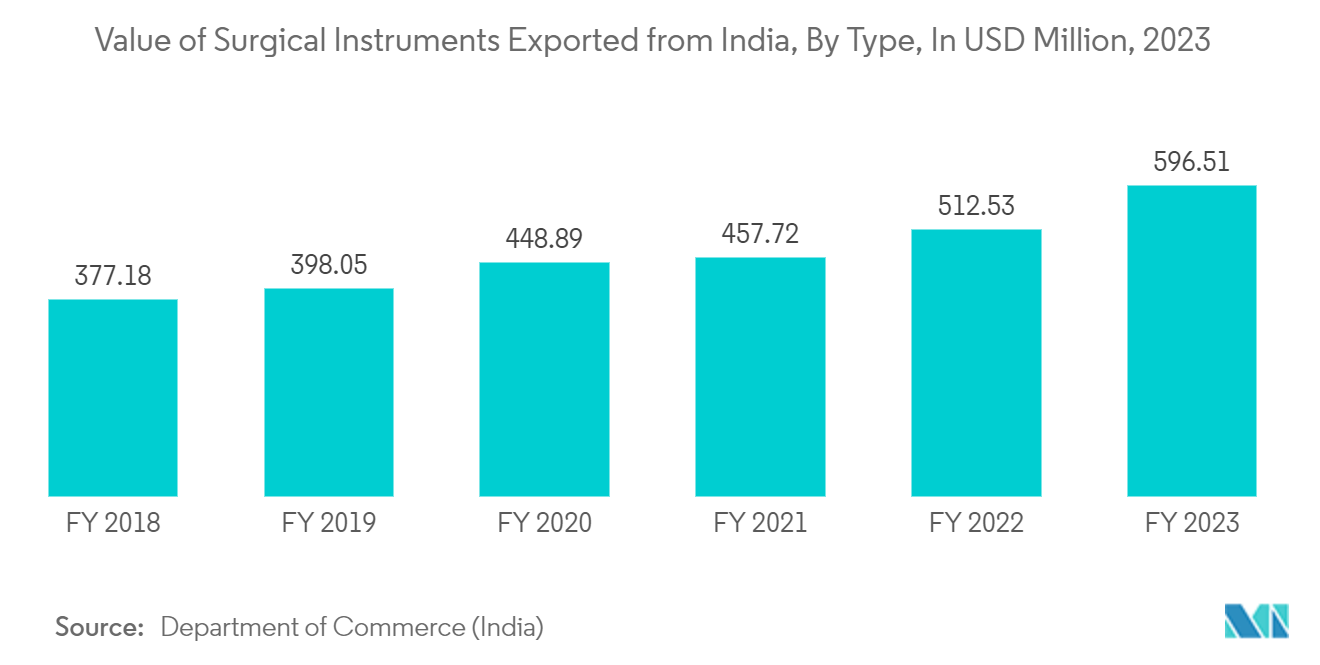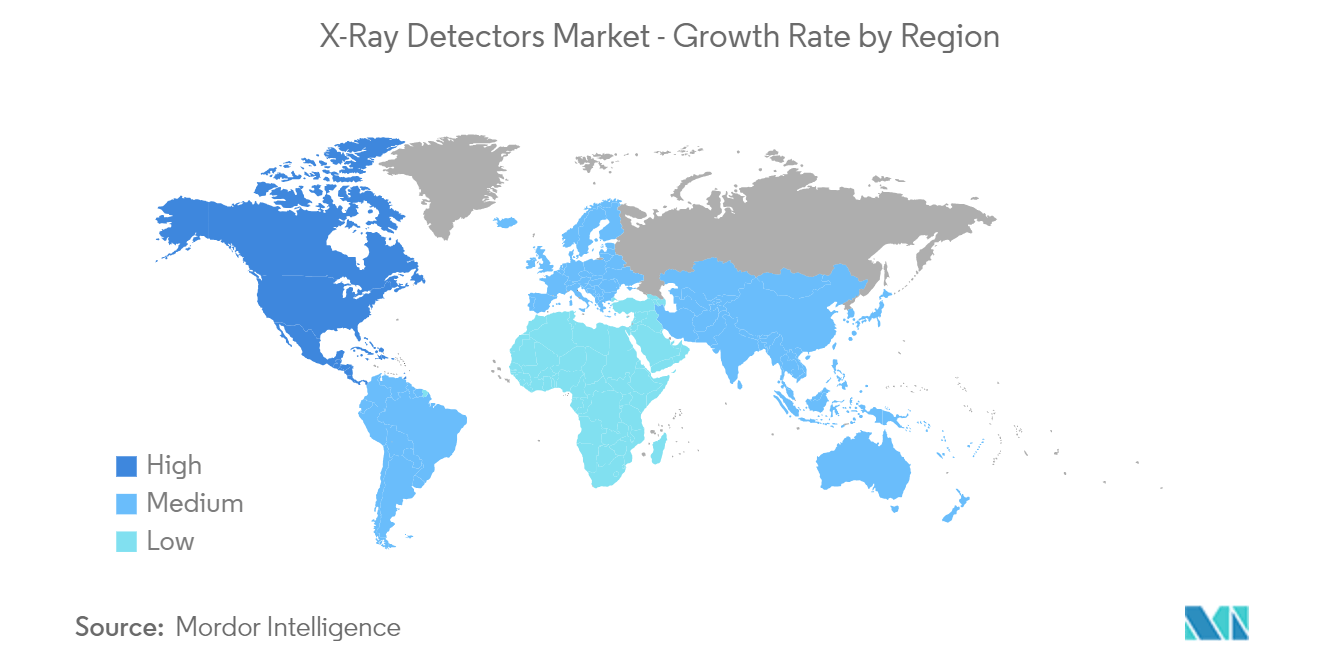
X-Ray Detector Market Analysis
The X-Ray Detectors Market size is estimated at USD 4.28 billion in 2025, and is expected to reach USD 5.83 billion by 2030, at a CAGR of 6.4% during the forecast period (2025-2030).
The healthcare industry trends rapidly evolve due to technological advancements and innovation, improving healthcare services and care quality. Following the escalating demand for diagnostics, numerous global market participants are vying for product launches and innovations. This factor has expanded research and development (R&D) activity and expenditure to build X-ray detectors.
- X-ray detectors have undergone several innovations in size and performance over the past few decades, aided by technological advancements and increasing demand from various end-user verticals. Further, the considerable advances in analytical procedures, such as combinations of instruments in a smaller space and indirect excitation of X-ray spectra bulk samples, are expected to surge the demand for the market over the foreseen period. With technological advancements, X-ray detection in the market has become safer, more effective, and more convenient.
- Increasing demand for mobile equipment in the market, especially from end-users, such as oil and gas, power generation, etc., to inspect the equipment installed in remote places that are not accessible through traditional X-ray inspection solutions, is pushing several innovations in the market. Also, inspection service providers in the market, which primarily benefit from mobile equipment, are encouraging mobile X-ray equipment's mass production. Owing to such demand, manufacturers are diversifying their product portfolios to suit the needs of industrial users.
- Several OEMs are planning to expand their footprint in the market. For instance, In June 2022, Punjab-based Allengers OEM (India), manufacturers of X-ray tubes, flat panel detectors, and monitors, is also expanding its capacity in the state, thus driving the demand for X-ray detectors. Two further significant factors impacting the growth of the FPDS industry are the declining cost of FPD (Flat Panel Detectors) and the increasing use of retrofit FPD (Flat Panel Detectors)
- Furthermore, the increasing demand for digital imaging technologies may propel the studied market demand. For instance, in October 2022, Google Cloud announced Medical Imaging Suite, a new technology it says can help with the accessibility and interoperability of radiology and other imaging data. According to Google Cloud, the new suite includes components focused on storage, lab, datasets, dashboards, and AI pipelines for imaging.
- Moreover, the ongoing conflict between Russia and Ukraine is expected to significantly impact the electronics industry. The conflict has already exacerbated the semiconductor supply chain issues and the chip shortage that have affected the industry for some time. The disruption may result in volatile pricing for critical raw materials such as nickel, palladium, copper, titanium, aluminum, and iron ore, resulting in material shortages. This would obstruct the manufacturing of X-ray film.
X-Ray Detector Market Trends
Medical Applications to Grow Significantly Over the Forecast Period
- Over the past few years, the expansion of the diagnostics and medical imaging sector has indicated a global demand for medical X-ray detectors. The medical devices industry is witnessing a growth in the number of imaging and diagnostic tests performed yearly owing to increasing focus on radiological diagnostic tests, rising chronic disease burden, and introduction of efficient X-ray instruments through consolidation and mergers in the medical appliances market.
- According to the UN data on World Population Prospects, the number of people over 65 is steadily increasing. By 2050, the world's population aged 60 years and older is anticipated to reach 2 billion, of which 80% will live in lower and middle-income nations.
- Hence, the rising geriatric population and an increasing number of orthopedic and cardiovascular procedures would further drive the adoption of X-ray detectors in medical applications. Also, the growing incidence of trauma, sports injuries, and cancer denotes a significant patient pool opting for diagnostic imaging tests annually, particularly in emerging countries. The ever-increasing prevalence of lung diseases further drives the need for effective screening methods to detect chest abnormalities, which supports the demand for X-ray detectors.
- For instance, in November 2022, In Smiths Detection, a provider of threat detection and security inspection technologies, announced that it had signed a memorandum of understanding (MoU) with Navratna Defence PSU (public sector undertakings) Bharat Electronics Limited (BEL) for the manufacture of advanced X-ray screening technologies in India. Such strategic collaborations are driving the demand for the X-ray detector market.
- The Indian healthcare industry reached USD 190 billion previously, and according to the India Brand Equity Foundation, it is expected to reach USD 370 billion by 2024-2025. This increase is due to the growing demand for specialized, higher-quality healthcare facilities. In addition, public spending on healthcare in India is predicted to increase by 2.5% by 2025.
- According to the Department of Commerce (India), at the end of fiscal year 2022, the export value for surgical instruments from India was approximately USD 512 million. A consistent increase in the export value of such devices was seen over the past several years.
United States is Expected to Account for Significant Market Share
- The rapid technological development in the medical field is now being merged with the technologies, such as advanced X-ray detectors. There is a strong focus on improving the health conditions of people, as well as tackling the adverse effects of rising health diseases and infections. Therefore, there needs to be a constant diagnostic and monitoring service driving the Market in the United States.
- In the United States, Health and Human Services (H.H.S.), governed by the cabinet-level department of the United States, is highly liberal in funding and maintaining technological research in medical sciences. According to Centers for Medicare & Medicaid Services, over 2022-2031, average growth in NHE (5.4%) is projected to outpace that of average G.D.P. growth (4.6%), resulting in an increase in the health spending share of G.D.P. from 18.3% in recently to 19.6% in 2031.
- The United States is witnessing a rise in the senior population and a surge in chronic diseases due to sedentary lifestyles and unhealthy eating habits. Moreover, rising medical infrastructure developments with increased medical facilities are expected to propel the demand for the medical X-ray detectors market in the United States.
- For instance, according to 2022 statistics published by the American Heart Association, the prevalence rate of heart failure in the United States is 6 million, 1.8% of the total population in the previous year. Additionally, according to 2022 statistics published by the International Diabetes Federation, people with diabetes are projected to reach 3,288.2 thousand by 2030 and 3,468.5 thousand by 2045.
- Companies such as Samsung Electronics, Cannon, and Fujifilm Medical Systems U.S.A. are strategically investing in producing new X-ray systems, which use X-ray detectors, and mobile X-ray systems, which use X-ray detectors. The production of these systems is anticipated to increase the use of X-ray detectors.
- For instance, in November 2022, Canon Medical Components U.S.A. Inc., a subsidiary of Canon Inc., announced a new product line-up at the Radiology Society of North America (RSNA) conference. Canon Medical Components U.S.A., Inc. displays several innovative products, some of which are available for the first time in the U.S. The CXDI-Elite series of Canon Medical Components U.S.A. has high sensitivity, high image quality, ultra-lightweight, ergonomic design for extended battery life, ease of handling, and AED4 function. This factor makes the CXDI-Elite the ideal digital radiography detector for mobile applications or any general X-ray need. The unique functions, Intelligent N.R., and Built-in AEC5 assistance expand the digital radiography possibilities.
X-Ray Detector Industry Overview
The X-ray detectors market is highly fragmented, and the essential players have formed strategic collaborations, agreements, expansions, partnerships, new product launches, joint ventures, acquisitions, and others to increase their footprints in this Market. Key players in the Market are Varex Imaging Corporation, PerkinElmer Inc., Thales Group, Fujifilm Medical Systems, Agfa Healthcare, Konica Minolta Inc., Canon Inc., Teledyne DALSA Inc., Analogic Corporation, Comet Holding AG, Hamamatsu Photonics KK, Rayence Co. Ltd, and many more.
In November 2022, Block Imaging announced an X-RAY partnership with Fujifilm Healthcare Solutions. With most Fujifilm products, providers can experience advanced image processing technology. Block Imaging is to offer a variety of new products that encompass innovative, cost-effective, and energy-efficient technology. Healthcare suppliers can rely on Block Imaging to deliver X-ray products such as the FDR ES detector, FDR D-EVO III and FDR D-EVO II detectors, Clinica X OTC and FDR Clinica X FS suites, and mobile digital radiography units like the FDR Go Plus and FDR AQRO. Now partnered with Fujifilm Healthcare Solutions, Block can strive to bring innovative technology to healthcare providers across the U.S.
In November 2022, Teledyne Dalsa has acquired the Sigmascreening B.V. patents and IP portfolio on pressure-sensitive mammography for screening. The unique combination of the detector and pressure-sensitive compression is expected to develop new possibilities for immediate diagnostic information and biomarkers for mammography. The group intends to expand the CMOS X-ray detector product line for mammography with new subsystem products for optimizing and improving patient comfort during mammographic screening.
X-Ray Detector Market Leaders
-
Varex Imaging Corporation
-
PerkinElmer Inc.
-
Fujifilm Medical Systems
-
Thales Group
-
Agfa Healthcare
- *Disclaimer: Major Players sorted in no particular order
X-Ray Detector Market News
- July 2024: DÜRR NDT has launched a new Series of Portable Digital X-Ray Detectors. The basic spatial resolution (SRb) is at the highest possible: 80 µm for the small and medium detectors and 100 µm for the bendable and large detectors. Due to weights ranging from 2 to 6 kg, the detectors are among the lightest in their class and are easy to handle. The D-DR 1025B detector has an innovative bending mechanism and due to its high resolution is perfectly suited for testing circumferential weld seams in accordance with DIN EN ISO 17636-2 (Class B).
- April 2024: Smiths Detection, a global firm in threat detection and security screening technologies, has announced the launch of the SDX 10060 XDi, an innovative X-ray scanner powered by diffraction technology. The SDX 10060 XDi automates the resolution of potential explosive alarms, thereby enhancing both security and efficiency.
X-Ray Detector Industry Segmentation
The energy transported by radiation is converted into forms that can be recognized visually or electronically by X-ray detectors. X-ray detectors have a wide range of veterinary, medical, dental, industrial, and security applications. Digitization led hospitals to convert their analog X-ray systems to digital systems. Developments in amorphous selenium (a-Se) detectors, which are helpful in mammography, have made the growth in this market more significant.
The X-ray detectors market is segmented by type (flat panel detectors (indirect flat panel detectors, and direct flat panel detectors), computed radiography (CR) detectors, charge-coupled device detectors, and other types of detectors), by portability (fixed detectors and portable detectors), by application (medical, dental, security, industrial, and other applications), and by geography( North America, United States, and Canada). The market sizes and forecasts are provided in terms of value in USD for all the above segments. Further, the disturbance of the factors affecting the Market's evolution in the near future has been covered in the study regarding drivers and constraints. The market sizes and predictions are provided in terms of value in USD for all the above segments.
| By Type | Flat Panel Detectors | Indirect Flat Panel Detectors | |
| Direct Flat Panel Detectors | |||
| Computed Radiography (CR) Detectors | |||
| Charge Coupled Device Detectors | |||
| Other Types | |||
| By Portability | Fixed Detectors | ||
| Portable Detectors | |||
| By Application | Medical | ||
| Dental | |||
| Security | |||
| Industrial | |||
| Other Applications | |||
| By Geography | North America | United States | |
| Canada | |||
| Europe | United Kingdom | ||
| Germany | |||
| France | |||
| Asia | China | ||
| Japan | |||
| India | |||
| Australia and New Zealand | |||
| Latin America | |||
| Middle East and Africa | |||
X-Ray Detector Market Research FAQs
How big is the X-Ray Detectors Market?
The X-Ray Detectors Market size is expected to reach USD 4.28 billion in 2025 and grow at a CAGR of 6.40% to reach USD 5.83 billion by 2030.
What is the current X-Ray Detectors Market size?
In 2025, the X-Ray Detectors Market size is expected to reach USD 4.28 billion.
Who are the key players in X-Ray Detectors Market?
Varex Imaging Corporation, PerkinElmer Inc., Fujifilm Medical Systems, Thales Group and Agfa Healthcare are the major companies operating in the X-Ray Detectors Market.
Which is the fastest growing region in X-Ray Detectors Market?
Asia Pacific is estimated to grow at the highest CAGR over the forecast period (2025-2030).
Which region has the biggest share in X-Ray Detectors Market?
In 2025, the North America accounts for the largest market share in X-Ray Detectors Market.
What years does this X-Ray Detectors Market cover, and what was the market size in 2024?
In 2024, the X-Ray Detectors Market size was estimated at USD 4.01 billion. The report covers the X-Ray Detectors Market historical market size for years: 2019, 2020, 2021, 2022, 2023 and 2024. The report also forecasts the X-Ray Detectors Market size for years: 2025, 2026, 2027, 2028, 2029 and 2030.
Our Best Selling Reports
X Ray Detectors Industry Report
Statistics for the 2025 X-Ray Detectors market share, size and revenue growth rate, created by Mordor Intelligence™ Industry Reports. X-Ray Detectors analysis includes a market forecast outlook for 2025 to 2030 and historical overview. Get a sample of this industry analysis as a free report PDF download.






